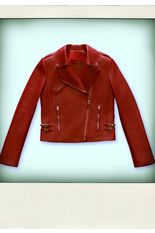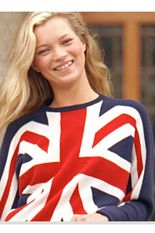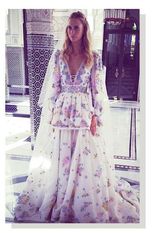How florals bloomed in fashion history
Flowers pop up so often in fashion that it's almost counterintuitive to call them a trend – they seem to be continually present in one form or another. They're not, after all, a design concept or an aesthetic; they're one of nature's most beautiful products, and something that generation after generation of creatives has been inspired by.
So it's unsurprising that they have a long and distinguished history in fashion. In the late Middle Ages they would crop up in woven velvets, imported from Ottoman textile manufacturers and later made by flourishing Italian craftsmen.
In the 17th and 18th centuries, Indian chintz – calico printed with floral designs – became a hugely popular import, a style that was to characterise the time of Jane Austen (and every film adaptation that came afterwards). But it wasn't until the industrial revolution that British mills gained the ability to manufacture large quantities of printed fabric on home soil. By the early 20th century, floral print dresses were commonplace – and that remains the case today.
Though floral imagery has endured, the way it's been treated has varied wildly. In the early days it was grand and luxurious – a status symbol. In the 1960s and 70s, prints became bohemian and organic in feel, but in the 1980s era of Sloane Rangers and Laura Ashley, they gained a reputation as a kind of conservative, establishment uniform for women. In the 21st century designers have been falling over themselves to reinvent the floral, deconstructing it and reimagining it in appliqué, digital manipulation and, in Christopher Kane's case, diagram form. The journey we've taken to this point has been more meandering and complicated than it might seem in memory.
And some of the most recent fashionable floral prints hearken back to the 19th century, as with Tory Burch's autumn 2014 take on florals: vintage botanical sketches on dresses and skirts.
But it was Liberty, one of the most famous and enduring designers of florals, who first began printing silks in the UK, soon after setting up shop in 1875. It wasn't until 1904 that the company took over a printworks in London. Today Liberty keeps a selection of older prints – mostly floral – and adds to these with seasonal prints twice a year.
Gucci also has a longterm association with florals, thanks to its 1966 Flora print – created by Rodolfo Gucci and artist Vittoria Accornero as a silk scarf for Princess Grace of Monaco. Featuring 43 varieties of flower, plant and insect, the print has since become one of the fashion house's trademarks, used across ready-to-wear and accessories.
The same year, Celia Birtwell began creating textiles for designer (and future husband) Ossie Clark. The prints were romantic and inspired by nature – perfect for a generation of freewheeling hippies. Together Birtwell and Clark created a unique look that was the height of fashion for six years; they dressed the Beatles, Jimmy Hendrix, Paloma Picasso, Twiggy and Marianne Faithfull, among others.
In the 1970s and 80s, the Welsh brand Laura Ashley became a household name – loved by the Chelsea set, including Princess Diana. The brand was known for its once hugely popular Victorian-inspired floral prints – but after the designer's death in 1985, the company's popularity began to decline.
Whereas Liberty prints still enjoy a reputation for being stylish, Laura Ashley florals came to be considered as frumpy and old-fashioned. In 2011 the company is still going strong, but with the focus more squarely on home furnishings.
In designer fashion, Balenciaga produced one of the most memorable floral collections of recent years for spring/summer 2008, with creative director Nicolas Ghesquière at the label's helm. The collection used archive prints alongside new designs, and featured powerful shapes that were inspired by sports car bodywork. 'This was Balenciaga in full bloom: a splashy riot of hypergorgeous hydrangeas, pansies, peonies, daffodils, and anemones – some of them Cristobal's own – but compressed into another of Ghesquière's short-sharp revolutionary essays in couture technique,' said Style.com's Sarah Mower. It was a reinvention of the floral.
And the style underwent something of a 'streetification', thanks to the design talents of Luella Bartley and her faithful crowd of It-girls during the late Noughties. Alexa Chung, Pixie Geldof and Daisy Lowe were just some of the names who were often to be found wearing sprig and ditzy print, flirty floral dresses from the London-based label.
In recent seasons London's young designers have been equally attracted by the idea of experimenting with flowers – and none more so than Erdem. In his latest collection, he dismissed the idea of prettiness and embraced a starker, more unexpected colour palette.
Jonathan Saunders, meanwhile, took the theme to sportswear with embroidered bomber jackets – a far cry from the fragile girliness that the flower has often been associated with.
Perhaps the biggest stir was created by Christopher Kane, who took an entirely original approach for SS14. He broke down the familiar flower to its anatomy, treating it as a textbook diagram.
The designs we see this season are still floral, but they're a world away from Liberty's ditzy prints or Gucci's whimsical illustrations. Read more on summer's future florals in the NEVER UNDERDRESSED trend guide.
Follow us @theneverteam
Follow me @hattiehattie


























